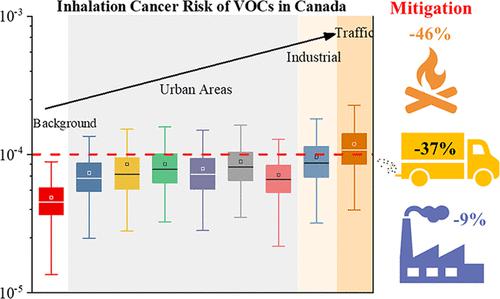当前位置:
X-MOL 学术
›
Environ. Sci. Technol.
›
论文详情
Our official English website, www.x-mol.net, welcomes your
feedback! (Note: you will need to create a separate account there.)
Health Risk-Oriented Source Apportionment of Hazardous Volatile Organic Compounds in Eight Canadian Cities and Implications for Prioritizing Mitigation Strategies
Environmental Science & Technology ( IF 10.8 ) Pub Date : 2022-08-08 , DOI: 10.1021/acs.est.2c02558 Ying Xiong 1, 2 , Yaoxian Huang 2 , Ke Du 1
Environmental Science & Technology ( IF 10.8 ) Pub Date : 2022-08-08 , DOI: 10.1021/acs.est.2c02558 Ying Xiong 1, 2 , Yaoxian Huang 2 , Ke Du 1
Affiliation

|
Traditionally, environmental authorities make regulatory policies for controlling volatile organic compound (VOC) pollution based on the mitigation of dominant VOC sources. However, the emission from each VOC source has a unique combination of VOC species of different toxicities. Without quantitatively assessing the health risk associated with each source, the effectiveness of the mitigation policy could be undermined. To address this shortcoming, we developed a new health risk-oriented source apportionment method that can provide quantitative health risk assessment and source-specific mitigation strategies for hazardous VOCs. We estimated that the integrated inhalation cancer risk (ICR) of hazardous VOCs was 7.7 × 10–5 in Western Canada, indicating a 100% likelihood of exceeding Health Canada’s acceptable risk level (1.0 × 10–5). Anthropogenic sources were responsible for 56.3–73.8% of cancer risks across eight Canadian cities except for the regional background island, where natural sources contributed over 77% to the integrated ICR. Thus, substantial environmental and health cobenefits could be achieved via reducing the ambient levels of benzene and 1,3-butadiene by 39.3–75.7 and 14–69.3%, respectively, and mitigating emissions from fuel combustion (by 31.3–54.1%), traffic source (3.0–36.8%), and other anthropogenic sources (5.3–20.1%) in Western Canada. Our study has significant implications for prioritizing air pollution mitigation policies, especially for quantitative reduction of hazardous air pollutants.
中文翻译:

加拿大八个城市危险挥发性有机化合物的健康风险源分析及其对优先缓解策略的影响
传统上,环保部门根据主要 VOC 来源的缓解制定控制挥发性有机化合物 (VOC) 污染的监管政策。然而,每个 VOC 源的排放物具有不同毒性的 VOC 种类的独特组合。如果不定量评估与每个来源相关的健康风险,缓解政策的有效性可能会受到损害。为了解决这个缺点,我们开发了一种新的面向健康风险的源分配方法,可以为有害 VOCs 提供定量的健康风险评估和特定源的缓解策略。我们估计有害 VOC 的综合吸入癌症风险 (ICR) 为 7.7 × 10 –5在加拿大西部,表明超过加拿大卫生部可接受的风险水平 (1.0 × 10 –5 ) 的可能性为 100%。人为来源对加拿大 8 个城市的癌症风险的 56.3-73.8% 负责,但区域背景岛除外,那里的自然来源对综合 ICR 的贡献超过 77%。因此,通过将苯和 1,3-丁二烯的环境水平分别降低 39.3-75.7% 和 14-69.3%,并减少燃料燃烧的排放(降低 31.3-54.1%)、交通源(3.0-36.8%)和加拿大西部的其他人为源(5.3-20.1%)。我们的研究对于优先考虑空气污染缓解政策具有重要意义,特别是对于定量减少有害空气污染物。
更新日期:2022-08-08
中文翻译:

加拿大八个城市危险挥发性有机化合物的健康风险源分析及其对优先缓解策略的影响
传统上,环保部门根据主要 VOC 来源的缓解制定控制挥发性有机化合物 (VOC) 污染的监管政策。然而,每个 VOC 源的排放物具有不同毒性的 VOC 种类的独特组合。如果不定量评估与每个来源相关的健康风险,缓解政策的有效性可能会受到损害。为了解决这个缺点,我们开发了一种新的面向健康风险的源分配方法,可以为有害 VOCs 提供定量的健康风险评估和特定源的缓解策略。我们估计有害 VOC 的综合吸入癌症风险 (ICR) 为 7.7 × 10 –5在加拿大西部,表明超过加拿大卫生部可接受的风险水平 (1.0 × 10 –5 ) 的可能性为 100%。人为来源对加拿大 8 个城市的癌症风险的 56.3-73.8% 负责,但区域背景岛除外,那里的自然来源对综合 ICR 的贡献超过 77%。因此,通过将苯和 1,3-丁二烯的环境水平分别降低 39.3-75.7% 和 14-69.3%,并减少燃料燃烧的排放(降低 31.3-54.1%)、交通源(3.0-36.8%)和加拿大西部的其他人为源(5.3-20.1%)。我们的研究对于优先考虑空气污染缓解政策具有重要意义,特别是对于定量减少有害空气污染物。











































 京公网安备 11010802027423号
京公网安备 11010802027423号